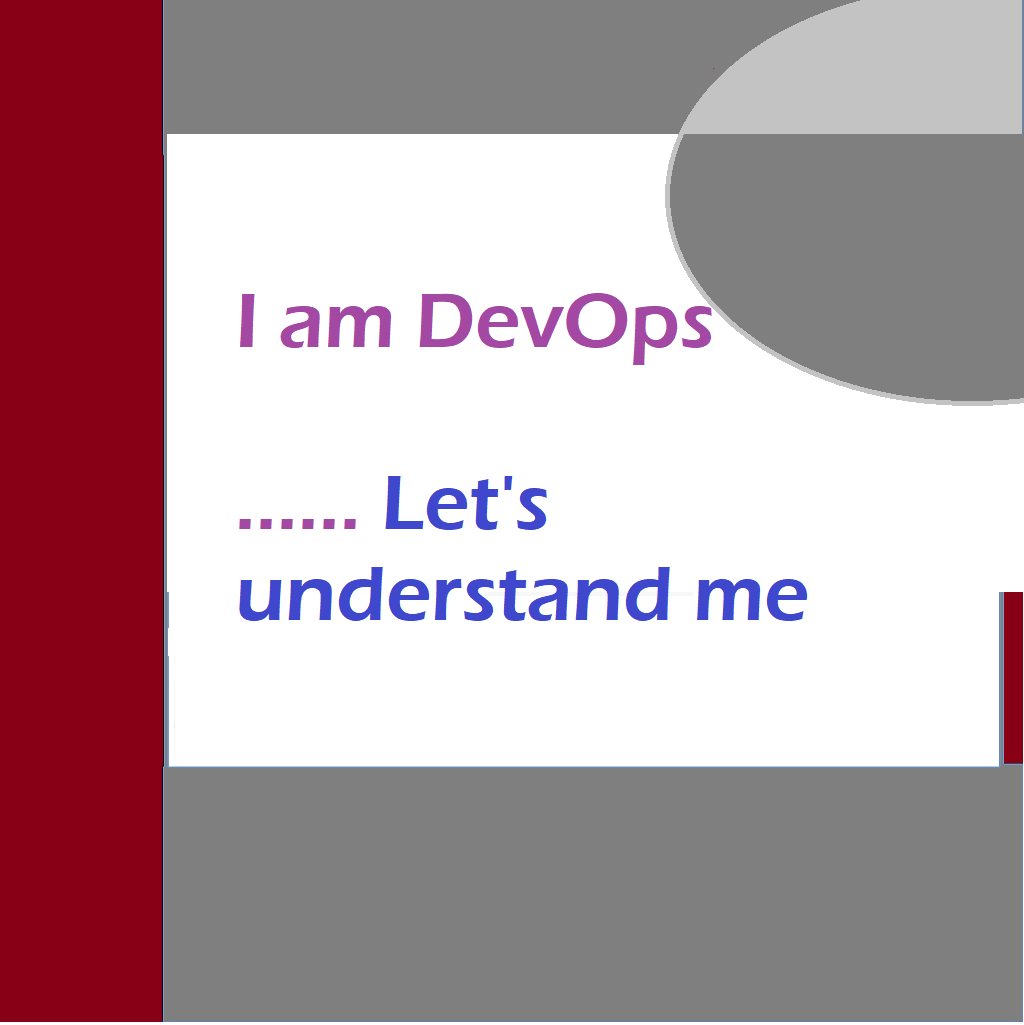People came up with DevOps in response to the challenges and inefficiencies observed in traditional software development and IT operations. The need for faster, more reliable software delivery, along with the increasing complexity of modern IT environments, called for a more collaborative and streamlined approach. DevOps emerged as a solution to bridge the gap between development and operations teams, promoting a culture of collaboration, automation, and continuous improvement. By breaking down silos, implementing automation, and emphasizing communication and feedback, DevOps aims to enhance productivity, quality, and customer satisfaction. Ultimately, the goal of DevOps is to enable organizations to deliver software more quickly, efficiently, and with higher reliability in today’s fast-paced and technology-driven world. DevOps is a term that combines the words “development” and “operations” and refers to a set of practices, methodologies, and cultural philosophies aimed at improving collaboration, communication, and integration between software developers and IT operations teams. The main goal of DevOps is to streamline the software development and deployment processes, ensuring faster, more frequent, and more reliable delivery of software applications. The term “DevOps” was coined by two individuals: Patrick Debois and Andrew Clay Shafer.
Patrick Debois is often credited as the person who first used the term “DevOps.” He organized the first DevOpsDays conference in 2009, which brought together developers and operations professionals to discuss collaboration, automation, and cultural changes in software delivery.
Andrew Clay Shafer, while not directly responsible for coining the term, played a significant role in popularizing it. He gave a talk titled “10 Deploys per Day: Dev and Ops Cooperation at Flickr” at the Velocity Conference in 2009, which showcased the collaboration between development and operations teams at Flickr and how it enabled frequent software deployments.
Together, the efforts of Patrick Debois and Andrew Clay Shafer helped popularize the term “DevOps” and bring attention to the need for improved collaboration and integration between development and operations teams in software delivery.
Traditionally, development and operations teams have operated in separate silos, leading to inefficiencies, delays, and miscommunications. DevOps seeks to break down these barriers by fostering a culture of collaboration, shared responsibility, and automation. It encourages close cooperation between developers, system administrators, quality assurance engineers, and other stakeholders throughout the entire software development lifecycle.
CONTENT
Industries where devops is a good fit
History of devops
The history of DevOps can be traced back to the early 2000s when the software development and IT operations communities started recognizing the need for a more collaborative and streamlined approach to deliver software. The traditional waterfall model of software development, characterized by sequential phases and handoffs between teams, was seen as slow, inefficient, and prone to errors. DevOps, as a concept and movement, does not have a single inventor. It emerged as a response to the challenges and needs of the software development and IT operations communities. Rather than being attributed to an individual, DevOps has evolved through the collective efforts and experiences of numerous industry professionals, practitioners, and thought leaders.
The term “DevOps” is believed to have originated from a series of discussions and presentations held around 2007-2008, with the goal of bridging the gap between development and operations teams. However, the principles and practices that underpin DevOps have roots in earlier methodologies such as Agile, Lean, and Continuous Delivery.
Several notable individuals and organizations have contributed significantly to shaping and popularizing DevOps practices. Some influential figures in the DevOps movement include Patrick Debois, who organized the first DevOpsDays conference, Andrew Shafer, who coined the term “Infrastructure as Code,” and John Allspaw and Paul Hammond, who presented the “10+ Deploys per Day” case study at the Velocity Conference.
DevOps has been further developed and expanded through the collaboration and knowledge sharing within the broader community. Online forums, conferences, books, and open-source initiatives have played a crucial role in promoting the adoption and advancement of DevOps practices.
Hence, DevOps is the result of collective efforts and collaboration within the software development and IT operations communities, with contributions from various individuals and organizations over time. It continues to evolve as new technologies, methodologies, and practices emerge, driving continuous improvement in software development and delivery processes.Several key events and influences have shaped the evolution of DevOps:
- Agile Manifesto (2001): The Agile Manifesto introduced a set of principles for lightweight and iterative software development, emphasizing close collaboration between developers and customers, frequent delivery of working software, and adaptability to changing requirements. Agile methodologies like Scrum and Kanban laid the foundation for DevOps principles.
- Infrastructure as Code (IaC) Emergence: With the rise of virtualization technologies and cloud computing, the idea of treating infrastructure provisioning and management as code gained traction. Tools like Puppet and Chef, introduced in the mid-2000s, allowed for automated configuration and streamlined management of infrastructure resources.
- “10+ Deploys per Day” (2009): In 2009, John Allspaw and Paul Hammond presented a talk at the Velocity Conference, sharing how Flickr was able to achieve frequent deployments, sometimes multiple times a day. This served as inspiration for the industry, highlighting the benefits of small, incremental changes and continuous delivery.
- DevOpsDays (2009): The first DevOpsDays conference was held in Ghent, Belgium, in 2009. It brought together developers and operations professionals to discuss collaboration, automation, and cultural changes needed to improve software delivery. DevOpsDays conferences have since become popular worldwide, fostering knowledge sharing and community building.
- Continuous Integration and Continuous Delivery (CI/CD): The practice of continuous integration, where developers frequently merge code changes into a shared repository and run automated tests, gained prominence. This was followed by the concept of continuous delivery, which extends CI by automating the deployment process and making software ready for production at any point.
- The Phoenix Project (2013): Gene Kim’s book “The Phoenix Project” depicted a fictional story of an IT department struggling with delays, bottlenecks, and low-quality software. It highlighted the importance of DevOps principles, including collaboration, automation, and streamlining workflows, to overcome these challenges.
- DevOps Tooling and Ecosystem: A wide range of tools emerged to support DevOps practices. Version control systems like Git, continuous integration servers like Jenkins, configuration management tools like Ansible and Chef, containerization platforms like Docker and Kubernetes, and cloud platforms provided the technical foundation for implementing DevOps practices.
Today, DevOps has gained widespread adoption, with organizations recognizing its potential to enhance collaboration, accelerate software delivery, improve quality, and enable faster innovation. The DevOps movement continues to evolve, incorporating new technologies, methodologies, and cultural practices to meet the evolving needs of modern software development and operations.
Key Principles
Its interesting to know a few key principles of DevOps.
- Continuous Integration and Continuous Delivery (CI/CD): The practice of regularly integrating code changes, building, testing, and delivering software in small, incremental steps. This allows for rapid feedback, early bug detection, and the ability to quickly release new features and updates.
- Infrastructure as Code (IaC): Treating infrastructure provisioning, configuration, and management as code, enabling automation, version control, and reproducibility. Tools like configuration management systems and containerization technologies are often used to achieve this.
- Automation: Automating repetitive tasks, such as build and deployment processes, testing, and infrastructure provisioning, to minimize human error, increase efficiency, and free up time for more valuable activities.
- Collaboration and Communication: Encouraging cross-functional teams to work together closely, share knowledge, and communicate effectively. This includes breaking down organizational silos, fostering a blameless culture, and promoting open feedback and learning.
- Monitoring and Feedback: Implementing robust monitoring and logging systems to gain visibility into application and infrastructure performance. Feedback loops help identify issues, track metrics, and drive continuous improvement.
DevOps is not limited to specific tools or technologies but rather emphasizes the cultural and collaborative aspects of software development and operations. Popular tools used in DevOps practices include version control systems (e.g., Git), continuous integration servers (e.g., Jenkins), configuration management tools (e.g., Ansible), containerization platforms (e.g., Docker, Kubernetes), and cloud platforms (e.g., AWS, Azure).
Who should use devops?
DevOps principles and practices can benefit a wide range of organizations and teams involved in software development and IT operations. Here are some groups that can benefit from adopting DevOps:
- Software Development Teams: Development teams that aim to increase their development speed, improve collaboration, and enhance the quality of their software can benefit from adopting DevOps practices. By implementing continuous integration, automated testing, and continuous delivery, developers can streamline their workflows, catch bugs early, and deliver features more frequently.
- IT Operations Teams: Operations teams responsible for deploying and managing software applications can benefit from DevOps by automating infrastructure provisioning, configuration management, and deployment processes. Infrastructure as Code (IaC) practices and tools enable reproducibility, scalability, and faster response to changing requirements or issues.
- System Administrators: System administrators can leverage DevOps practices to streamline their administrative tasks, automate repetitive processes, and achieve greater efficiency in managing complex IT environments. By adopting infrastructure automation and monitoring techniques, they can ensure system reliability, scalability, and improved incident response.
- Quality Assurance (QA) Teams: QA teams play a vital role in ensuring the quality and reliability of software. With DevOps, QA teams can collaborate more closely with developers and operations teams, enabling continuous testing and early bug detection. Automation of testing processes can reduce manual effort, improve test coverage, and enhance the overall quality of the software.
- Project Managers: DevOps can benefit project managers by providing them with better visibility into the software development and delivery processes. The use of collaborative tools, metrics, and automation allows project managers to track progress, identify bottlenecks, and make data-driven decisions to ensure timely and successful project delivery.
- Startups and Small Businesses: DevOps can be particularly beneficial for startups and small businesses, where agility, speed, and resource efficiency are crucial. By implementing DevOps practices from the beginning, these organizations can establish a culture of collaboration, automate processes, and rapidly deliver software, thereby gaining a competitive edge.
Therefore its essentail to note that while DevOps can benefit various teams, its successful implementation requires organizational commitment, cultural transformation, and investment in appropriate tools and technologies. DevOps is a mindset and a set of practices that can be tailored to suit the specific needs and goals of an organization.
The DevOps process
The DevOps process encompasses several key practices and stages that facilitate the collaboration and integration of development and operations teams. Here is an overview of the typical DevOps process:
1. Plan: This stage involves defining project goals, identifying requirements, and planning the development and deployment process. It includes tasks such as backlog grooming, prioritizing features, and setting project timelines.
2. Develop: In this stage, developers write code, following best practices such as modular and maintainable coding standards. They work collaboratively, utilizing version control systems to track changes and ensure code integrity.
3. Build: The build stage involves compiling the code, running tests, and generating build artifacts. Continuous Integration (CI) practices come into play, where developers frequently integrate their changes into a shared repository. Automated build systems and test frameworks help identify errors early on.
4. Test: Testing is a crucial aspect of the DevOps process. Automated testing is employed to validate the software’s functionality, performance, and security. Different types of tests, including unit tests, integration tests, and end-to-end tests, are executed to ensure the software meets quality standards.
5. Deploy: The deployment stage focuses on automating the deployment process to ensure consistent and reliable application deployment. Infrastructure as Code (IaC) tools and containerization technologies enable the provisioning and configuration of infrastructure resources in a repeatable and automated manner.
6. Operate: Once the application is deployed, it enters the operational phase. Continuous Monitoring and logging mechanisms are put in place to track application performance, detect anomalies, and identify potential issues. This data helps in maintaining the system’s health, ensuring availability, and delivering a positive user experience.
7. Monitor: Monitoring plays a critical role in DevOps, providing insights into application and infrastructure performance. Metrics, logs, and alerts are continuously collected and analyzed to identify bottlenecks, optimize resource utilization, and respond to incidents promptly.
8. Iterate: The DevOps process emphasizes continuous improvement. Feedback loops are established to gather insights from users, stakeholders, and team members. This feedback drives iterative development, where new features, enhancements, and bug fixes are prioritized and integrated into the development cycle.
The DevOps process is characterized by automation, collaboration, and iterative development. It promotes the use of tools and technologies that enable efficient workflows, continuous integration and delivery, infrastructure automation, and proactive monitoring. By following this process, organizations can achieve faster time-to-market, improved software quality, and enhanced customer satisfaction.
The most likely industry where devops can be used
DevOps principles and practices can be applied in a wide range of industries. However, certain industries have shown a greater adoption and integration of DevOps due to their specific needs and characteristics. Here are a few industries where DevOps is commonly used:
1. Technology and Software Development: The technology industry, including software development companies, startups, and IT service providers, has been at the forefront of adopting DevOps. These organizations rely heavily on continuous delivery, agile development methodologies, and automated infrastructure provisioning to ensure fast-paced development cycles and deliver high-quality software.
2. E-commerce and Retail: With the growth of online shopping and the increasing demand for seamless customer experiences, e-commerce and retail companies have embraced DevOps. DevOps enables these organizations to rapidly deploy and update their e-commerce platforms, handle high traffic loads during peak seasons, and ensure reliable order fulfillment and customer service.
3. Finance and Banking: The finance and banking industry, which heavily relies on technology for various operations, has recognized the value of DevOps. DevOps helps financial institutions streamline their software development and delivery processes, reduce time-to-market for new financial products and services, enhance security and compliance, and improve overall operational efficiency.
4. Telecommunications: Telecommunications companies face the challenge of managing complex networks, deploying new services, and ensuring network reliability. DevOps practices enable them to automate network configuration and management, accelerate the deployment of network infrastructure, and enhance the customer experience by delivering new services and resolving issues promptly.
5. Healthcare and Life Sciences: The healthcare industry has started adopting DevOps to improve patient care, manage healthcare IT systems, and accelerate the development of innovative medical solutions. DevOps enables healthcare organizations to streamline software development for electronic health records (EHRs), medical imaging, and telemedicine applications, ensuring secure and reliable delivery of healthcare services.
6. Media and Entertainment: The media and entertainment industry relies on digital platforms and content delivery systems for broadcasting, streaming, and content distribution. DevOps helps media companies ensure efficient content management, automate media workflows, and deliver content to a global audience with minimal downtime.
It’s worth noting that while these industries have seen significant adoption of DevOps, the principles and practices of DevOps can be beneficial and applied to almost any industry where software development and IT operations are involved. The key is to tailor DevOps practices to meet the specific requirements and challenges of each industry.
Tools for devops
There are numerous tools available that support different aspects of the DevOps process, and the choice of tools depends on specific requirements and preferences. Here are some popular categories of tools used in DevOps:
1. Version Control Systems: Git, Mercurial, Subversion
– These tools enable teams to manage and track changes to source code, collaborate on development, and maintain version history.
2. Continuous Integration/Continuous Delivery (CI/CD) Tools:
Jenkins, GitLab CI/CD, Travis CI, CircleCI
– CI/CD tools automate the building, testing, and deployment of software, enabling frequent and reliable software releases.
3. Configuration Management Tools: Ansible, Chef, Puppet
– These tools automate the provisioning, configuration, and management of infrastructure resources, ensuring consistency and scalability.
4. Containerization and Orchestration Tools:
Docker, Kubernetes, Docker Compose
– Containerization tools provide a lightweight and isolated environment for applications, while orchestration tools manage container deployment, scaling, and monitoring.
5. Infrastructure as Code (IaC) Tools:
Terraform, AWS CloudFormation, Azure Resource Manager
– IaC tools allow for the provisioning and management of infrastructure resources through code, ensuring reproducibility and automation.
6. Continuous Monitoring Tools:
Prometheus, Grafana, ELK Stack (Elasticsearch, Logstash, Kibana)
– These tools monitor application and infrastructure performance, collect and analyze metrics and logs, and provide visibility into the health of systems.
7. Collaboration and Communication Tools:
Slack, Microsoft Teams, Jira, Confluence
– These tools facilitate effective communication, collaboration, and project management among team members, stakeholders, and clients.
8. Testing Tools:
Selenium, JUnit, pytest
– Testing tools help automate the testing process, including unit testing, integration testing, and end-to-end testing, ensuring software quality and reliability.
Its evident that the choice of tools should align with the specific needs, technical stack, and budget of the organization. Additionally, tool selection should consider factors such as ease of use, integration capabilities, community support, and scalability. It’s advisable to evaluate and experiment with different tools to determine the best fit for your organization’s DevOps requirements.





